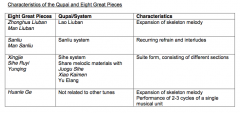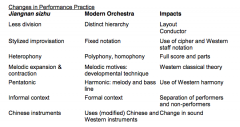![]()
![]()
![]()
Use LEFT and RIGHT arrow keys to navigate between flashcards;
Use UP and DOWN arrow keys to flip the card;
H to show hint;
A reads text to speech;
17 Cards in this Set
- Front
- Back
|
what does sizhu mean? |
• literally means 'silk and bamboo" • refers to genre of chinese music which string and wind instruments dominate |
|
|
what is Jiangnan? |
• 'South of the river" • includes Jiangsu, Zhejiang, Anhui provinces, municipality of Shanghai |
|
|
what three groups of instruments does sizhu use? |
strings (silk) winds (bamboo) percussion |
|
|
what are the three wind instruments used? |
1. dizi: bamboo flute 2. xiao: end blown bamboo flute 3. sheng: free reed bamboo pipes |
|
|
what are the three stringed instruments used? |
|
|
|
what are the three percussion instruments used? |
|
|
|
what is the social organisation of jiangnan sizhu clubs? |
|
|
|
what is typical of a chinese ensemble rehearsal/performance? |
|
|
|
what are the aesthetics of Jiangnan Sizhu? (3) |
1. core repetoire is "ba daqu" (8 great pieces) 2. each musician plays the melody slightly differently from other musicians--> heterophony 3. emphasis on realisation of pieces rather than mere repetition |
|
|
Characteristics of Qupai and 8 Great Pieces |

|
|
|
define: qupai |
labelled tunes |
|
|
how does lao liuban function as a qupai and what are its characteristics? |
• qupai for Zhonghua Liuban and Man Liuban • characteristics: expansion of basic qupai; density changes but qupai structure remains |
|
|
what different performance practices are there? |
1. techniques related to certain instruments 2. regional styles 3. performance standards 4. tastes of individual performer/ensemble 5. interaction with ensemble is more important than individual
|
|
|
what musical and social changes happened in china in the 20th century? |
1. question Chinese traditional validity 2. Wester = practicality/modern 3. May 4th movement: obstacle to modernization |
|
|
what is the progression of western influence on Chinese music? |
1. western music superior to chinese music (western > Chinese) 2. combined western and chinese music (western = chinese) 3. development and experiment with chinese music (modern = chinese) |
|
|
what did a modern Chinese orchestra symbolise in china during the 20th century? |
• modernization • influence of the west • progression of traditional chinese music, still maintains love for chinese music |
|
|
how does traditional sizhu compare with modern chinese orchestra? |

|

